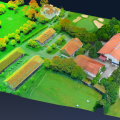.jpg)
An Austrian archaeological team has used radar imaging to uncover the history of a 3,500 year-old city. The images show the extent of the ruins of what was once the capital of Egypt.
Egypt was ruled for a century from 1664-1569 BC by the Hyksos, a group of warriors from Asia whose summer capital, Avaris, was in the northern Delta area.
The aim of the team’s magnetometric and resistivity survey was to define the borders of ancient Avaris, which is now thought to have covered approximately 2.6 square kilometres of land.
Egypt's Delta is densely populated and heavily farmed, making extensive excavation difficult. Increasingly, leading archaeologists are relying on technology, such as aerial techniques, in their research.
Zahi Hawass, Secretary General of the Supreme Council of Antiquities said that the computer-generated images of the city, which is still buried under the ground, show a detailed layout of ancient Avaris.
“Using such a special scientific survey to locate such a city is the only way to gain a better understanding of such a large area at one time,” he said.
Several architectural features including houses, temples, streets, cemeteries and palaces can be seen. The team has also been able to identify the arrangement of neighbourhoods and living quarters.







